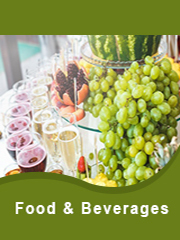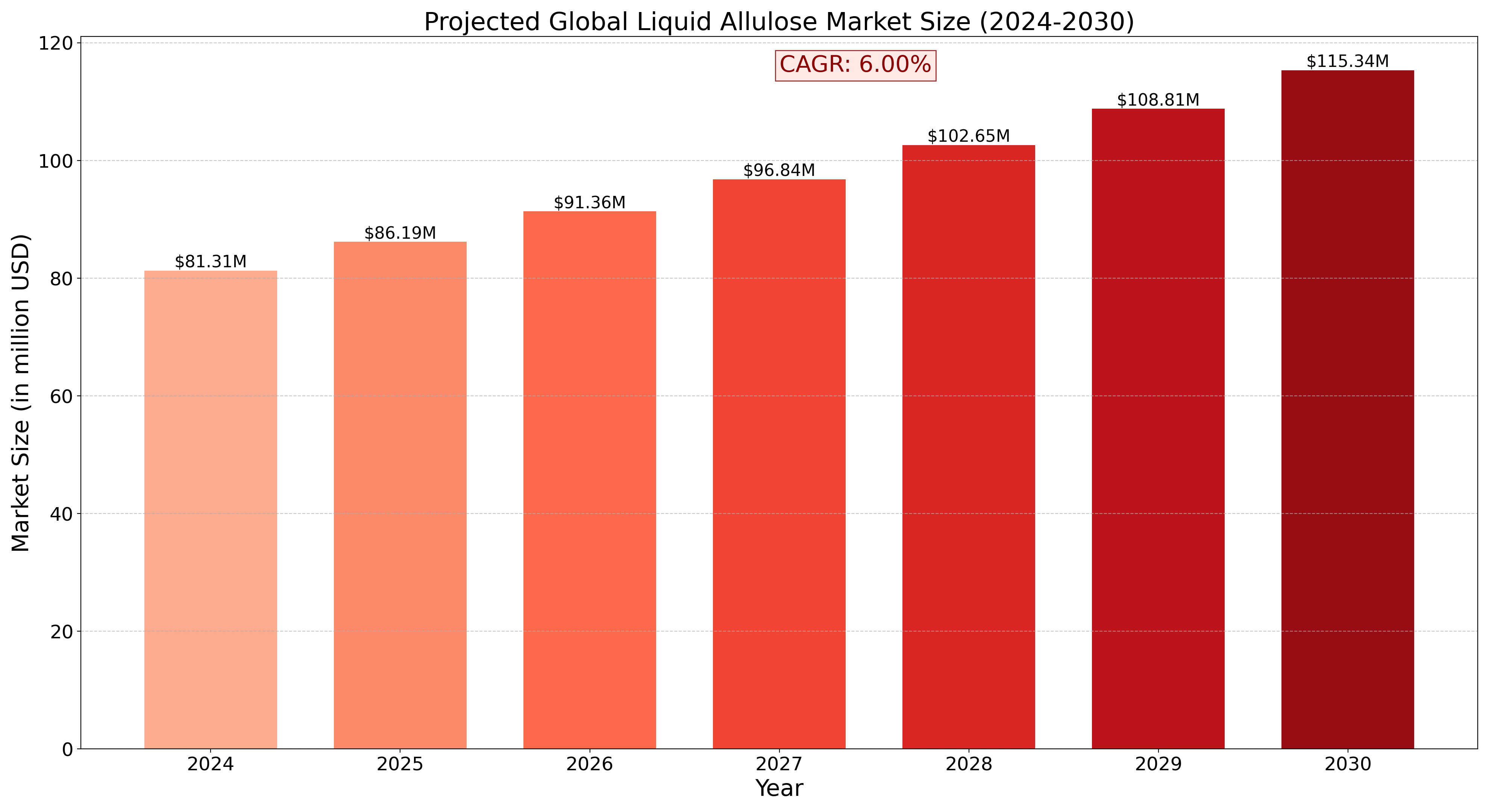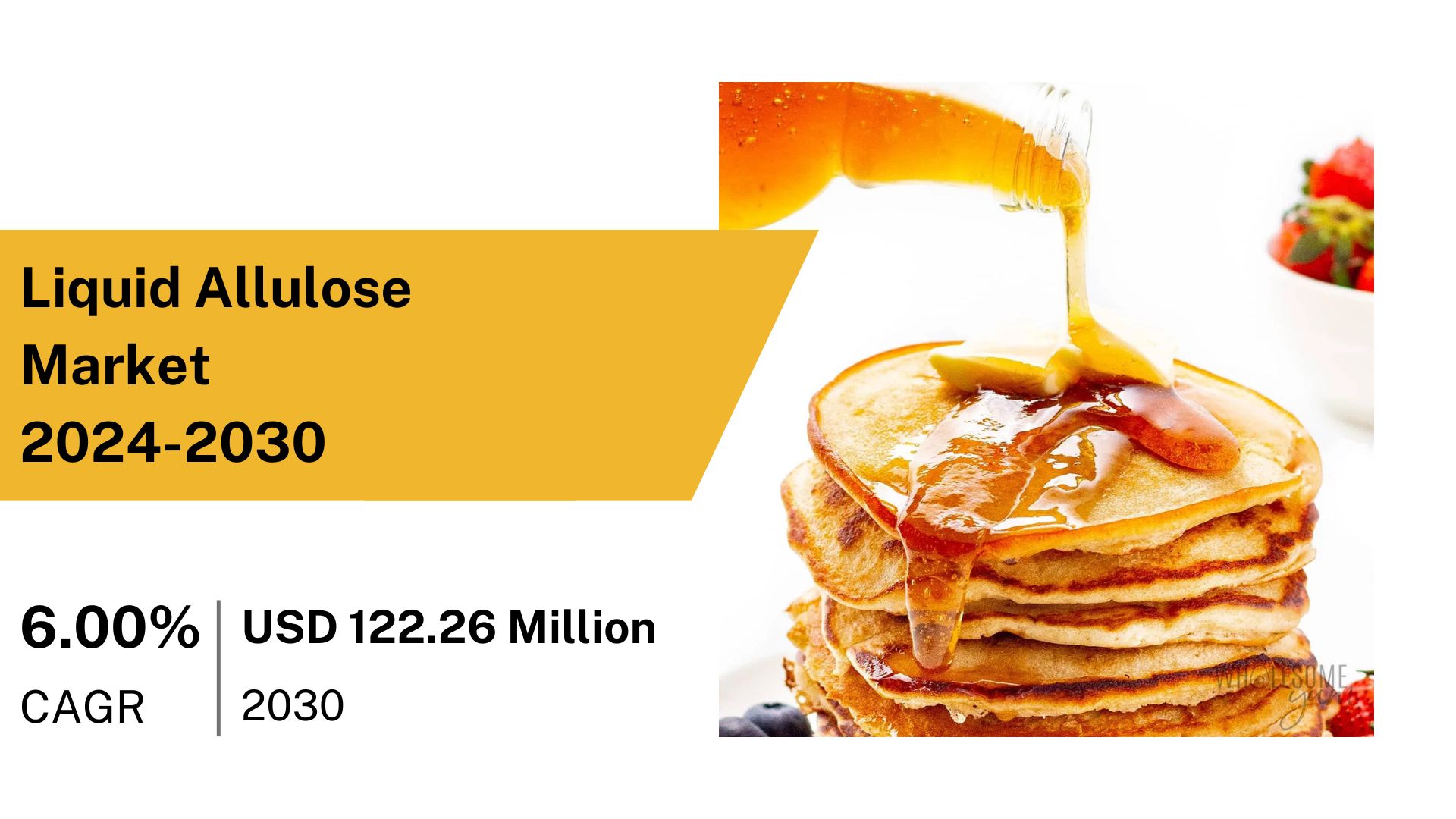TOP CATEGORY: Chemicals & Materials | Life Sciences | Banking & Finance | ICT Media

Download Report PDF Instantly
Report overview
The "Global Liquid Allulose Market" Size was estimated at USD 81.31 Million in 2024 and is projected to reach USD 122.26 Million by 2030, exhibiting a CAGR of 6.00% during the forecast period.
Liquid allulose, a low-calorie sugar substitute with 70% of the sweetness of sugar, is gaining momentum in the food and beverage industry due to its health benefits, especially for consumers looking for sugar alternatives. Its unique properties, such as no impact on blood glucose levels and negligible calories, make it highly attractive for various end-user segments.

Key End-User Segments:
Food & Beverage Manufacturers:
Market Share: Food and beverage manufacturers account for the largest share, approximately 65-70% of the liquid allulose market.
Usage: Widely used in a variety of products, including beverages, baked goods, sauces, and frozen desserts. Allulose is valued for its ability to provide sweetness without increasing the calorie count, making it ideal for health-conscious and diabetic-friendly products.
Key Trends:
Manufacturers are incorporating liquid allulose into sugar-reduced beverages, energy drinks, and sodas as a healthier alternative to high-fructose corn syrup.
Bakery products, such as cookies, muffins, and low-sugar pastries, are also seeing an increasing inclusion of allulose to cater to consumers seeking reduced sugar options without compromising taste and texture.
Consumer Demand: With growing concerns about obesity and diabetes, food manufacturers are seeing heightened demand for natural, low-calorie sweeteners, pushing allulose adoption.
Retailers and Supermarkets:
Market Share: Retail outlets, including supermarkets and health food stores, account for around 15-20% of the liquid allulose market.
Key Trends:
Supermarkets are increasingly stocking allulose-based sweeteners and syrups for direct consumer purchase, particularly targeting health-conscious shoppers looking to reduce their sugar intake.
Organic and specialty health food stores are seeing greater demand for liquid allulose, often promoting its benefits as a natural sugar alternative.
Private labels and supermarket brands are also entering the market with their own allulose-based products, making this sweetener more accessible to the mainstream consumer.
Consumer Preferences: Many consumers are choosing allulose for home use, primarily in cooking, baking, and beverages. Shoppers, particularly those following keto or low-carb diets, are driving the demand for allulose in sugar-free products.
Pharmaceutical and Nutraceutical Industry:
Market Share: Pharmaceutical and nutraceutical applications contribute about 5-7% of the total demand.
Usage: Allulose is used in the development of diabetic-friendly supplements, nutraceutical products, and medicinal formulations due to its minimal impact on blood sugar levels.
Trends:
Nutraceutical companies are increasingly using liquid allulose as a sweetener in functional foods and dietary supplements, especially products aimed at diabetic and health-conscious consumers.
In the pharmaceutical sector, liquid allulose is being researched and incorporated into products aimed at weight management and improving metabolic health.
Consumer Preferences: The growing demand for supplements that are low in sugar but still palatable is driving manufacturers to opt for allulose as a preferred sweetening agent.
Restaurants, Cafés, and Food Service:
Market Share: Restaurants and cafés contribute approximately 5-8% of the liquid allulose market.
Key Trends:
Increasing demand for healthier menu options has led cafés and restaurants to integrate liquid allulose into desserts, coffee drinks, and other sweetened products.
Low-calorie and sugar-free desserts, such as ice creams, cakes, and smoothies, are gaining popularity in food service establishments as more consumers look for guilt-free indulgences.
Consumer Preferences: Customers at health-conscious restaurants are increasingly seeking menu items that feature sugar substitutes like allulose, making it a popular choice for low-sugar dessert and beverage options.
Household Consumers:
Market Share: Household consumers represent around 10-12% of the liquid allulose market.
Buying Behavior:
Allulose is becoming a household staple for people who enjoy home cooking and baking but want to reduce sugar consumption. Consumers are using it in recipes ranging from desserts to smoothies and sauces.
Home bakers and individuals following low-carb, keto, and diabetic diets are key buyers of liquid allulose due to its similar taste and texture to sugar but with minimal calories.
Popular Uses: Household consumers commonly use liquid allulose for sweetening beverages, making homemade desserts, and incorporating it into everyday meals as a sugar substitute.
Key Trends: There is a growing interest in natural, plant-based sweeteners that do not spike blood sugar levels, which is a primary driver behind the adoption of allulose in households.
Regional Insights:
North America:
Market Share: North America leads the liquid allulose market with around 45-50% of global consumption.
Key Markets: The U.S. is the dominant market, driven by health trends and the food and beverage industry's push towards sugar reduction.
Trends: The demand for natural sweeteners and sugar alternatives is surging as consumers become increasingly health-conscious. Regulatory approvals from the FDA for allulose use in food products are also boosting the market.
Europe:
Market Share: Europe contributes around 20-25% of global demand.
Key Markets: The UK, Germany, and France are key players, with significant adoption in the bakery and confectionery sectors.
Trends: European consumers' preference for clean-label and low-calorie products has driven the use of allulose, especially in beverages and low-sugar snacks.
Asia-Pacific:
Market Share: Asia-Pacific holds about 15-20% of the market.
Key Drivers: Japan and South Korea are leading the way in terms of consumption, particularly in food and beverage applications. The rising incidence of diabetes and obesity in these regions is fueling the adoption of sugar alternatives like allulose.
Trends: The growing popularity of Western diets and rising awareness of metabolic health issues are driving demand for allulose in various food applications.
This report provides a deep insight into the global Liquid Allulose market covering all its essential aspects. This ranges from a macro overview of the market to micro details of the market size, competitive landscape, development trend, niche market, key market drivers and challenges, SWOT analysis, Porters five forces analysis, value chain analysis, etc.

The analysis helps the reader to shape the competition within the industries and strategies for the competitive environment to enhance the potential profit. Furthermore, it provides a simple framework for evaluating and accessing the position of the business organization. The report structure also focuses on the competitive landscape of the Global Liquid Allulose Market, this report introduces in detail the market share, market performance, product situation, operation situation, etc. of the main players, which helps the readers in the industry to identify the main competitors and deeply understand the competition pattern of the market.
In a word, this report is a must-read for industry players, investors, researchers, consultants, business strategists, and all those who have any kind of stake or are planning to foray into the Liquid Allulose market in any manner.
Global Liquid Allulose Market: Market Segmentation Analysis
The research report includes specific segments by region (country), manufacturers, Type, and Application. Market segmentation creates subsets of a market based on product type, end-user or application, Geographic, and other factors. By understanding the market segments, the decision-maker can leverage this targeting in the product, sales, and marketing strategies. Market segments can power your product development cycles by informing how you create product offerings for different segments.
Key Company:
Matsutani Chemical
Tate&Lyle
CJ CheilJedang
By Type:
Puree
Compounding Agent
By Application:
Beverages
Confectionery
Dairy
Other
Geographic Segmentation:
North America (USA, Canada, Mexico)
Europe (Germany, UK, France, Russia, Italy, Rest of Europe)
Asia-Pacific (China, Japan, South Korea, India, Southeast Asia, Rest of Asia-Pacific)
South America (Brazil, Argentina, Columbia, Rest of South America)
The Middle East and Africa (Saudi Arabia, UAE, Egypt, Nigeria, South Africa, Rest of MEA)
Key Benefits of This Market Research:
Industry drivers, restraints, and opportunities covered in the study
Neutral perspective on the market performance
Recent industry trends and developments
Competitive landscape & strategies of key players
Potential & niche segments and regions exhibiting promising growth covered
Historical, current, and projected market size, in terms of value
In-depth analysis of the Liquid Allulose Market
Key Reasons to Buy this Report:
Access to date statistics compiled by our researchers. These provide you with historical and forecast data, which is analyzed to tell you why your market is set to change
This enables you to anticipate market changes to remain ahead of your competitors
You will be able to copy data from the Excel spreadsheet straight into your marketing plans, business presentations, or other strategic documents
The concise analysis, clear graph, and table format will enable you to pinpoint the information you require quickly
Provision of market value (USD Billion) data for each segment and sub-segment
Indicates the region and segment that is expected to witness the fastest growth as well as to dominate the market
Analysis by geography highlighting the consumption of the product/service in the region as well as indicating the factors that are affecting the market within each region
Competitive landscape which incorporates the market ranking of the major players, along with new service/product launches, partnerships, business expansions, and acquisitions in the past five years of companies profiled
Extensive company profiles comprising of company overview, company insights, product benchmarking, and SWOT analysis for the major market players
The current as well as the future market outlook of the industry concerning recent developments which involve growth opportunities and drivers as well as challenges and restraints of both emerging as well as developed regions
Includes in-depth analysis of the market from various perspectives through Porters five forces analysis
Provides insight into the market through Value Chain
Market dynamics scenario, along with growth opportunities of the market in the years to come
6-month post-sales analyst support
Chapter Outline
Chapter 1 mainly introduces the statistical scope of the report, market division standards, and market research methods.
Chapter 2 is an executive summary of different market segments (by region, product type, application, etc), including the market size of each market segment, future development potential, and so on. It offers a high-level view of the current state of the Liquid Allulose Market and its likely evolution in the short to mid-term, and long term.
Chapter 3 makes a detailed analysis of the Market's Competitive Landscape of the market and provides the market share, capacity, output, price, latest development plan, merger, and acquisition information of the main manufacturers in the market.
Chapter 4 is the analysis of the whole market industrial chain, including the upstream and downstream of the industry, as well as Porter's five forces analysis.
Chapter 5 introduces the latest developments of the market, the driving factors and restrictive factors of the market, the challenges and risks faced by manufacturers in the industry, and the analysis of relevant policies in the industry.
Chapter 6 provides the analysis of various market segments according to product types, covering the market size and development potential of each market segment, to help readers find the blue ocean market in different market segments.
Chapter 7 provides the analysis of various market segments according to application, covering the market size and development potential of each market segment, to help readers find the blue ocean market in different downstream markets.
Chapter 8 provides a quantitative analysis of the market size and development potential of each region and its main countries and introduces the market development, future development prospects, market space, and capacity of each country in the world.
Chapter 9 introduces the basic situation of the main companies in the market in detail, including product sales revenue, sales volume, price, gross profit margin, market share, product introduction, recent development, etc.
Chapter 10 provides a quantitative analysis of the market size and development potential of each region in the next five years.
Chapter 11 provides a quantitative analysis of the market size and development potential of each market segment (product type and application) in the next five years.
Chapter 12 is the main points and conclusions of the report.